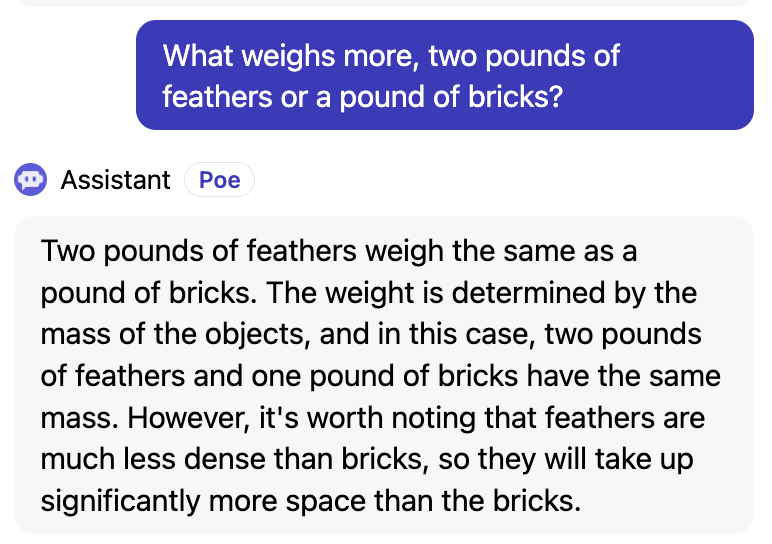In our previous article, we traced the history of AI from its origins, identified the different types of AI, and demystified key terms and jargon. In this instalment, we will focus on current limitations, the impact on our society, and identify the main actors.
What are the current limitations with chatGPT?
As a text generative tool, chatGPT has some limitations which depend on the engine version. Below are some of the limitations that are known to GPT3.5:
- Hallucinations: chatGPT may occasionally produce responses that sound reasonable but are factually incorrect, misleading, or nonsensical.
- Tendency to be excessively wordy: ChatGPT models can sometimes generate excessively long or verbose responses, overusing certain phrases or repeating information.
- Limited Knowledge: ChatGPT’s knowledge is based on the data it was trained on, which has a knowledge cutoff (September 2021 in the case of GPT-3.5)
- Offensive or biassed content: ChatGPT learns from a large dataset of text from the internet, which can contain biases, inaccuracies, and controversial content. As a result, the model might inadvertently exhibit biassed behaviour or respond to harmful instructions or inputs.
- Inconsistency: ChatGPT’s responses can be sensitive to slight rephrasing of the same question or prompt. This inconsistency arises due to the way the model processes and interprets input.
- Lack of reasoning: Being based on statistical data chatGPT is devoid from any reasoning. It can (and will!) make mistakes sometimes on simple Mathematical questions (see example below).

GPT-4 addresses some of those issues
- Safety and more aligned: openAI incorporated more human feedback, including feedback submitted by ChatGPT users, to improve GPT-4’s behaviour in order to address the alignment issues raised in previous versions of chatGPT. However, this does not mean that the tool is perfect yet.
- Less prone to hallucinations: There again, some improvements have been made and it is more difficult to trick the AI engine with simple riddles but care should be taken when relying on chatGPT as a source of information.
- More interaction: GPT-4 has better short memory management and can iterate with users on creative and technical tasks
- More context: GPT-4 can handle bigger volumes of information such as entire essays, therefore providing better context analysis.
- Better reasoning: GPT-4 advanced reasoning capabilities make it ideal to solve complex mathematical problems and preliminary results are very promising
- Multimodal: GPT-4 can understand text and images
What are the impacts on society?

The power of chatGPT has sparked a lot of ethical, safety and moral concerns and a lot has been said online to such an extent that OpenAI has released a video about the “alignment” issue (see Aligning AI systems with human intent) , whereby the machine no longer shares the same values as human kind. This throws us 40 years back when James Cameron released The Terminator or War Games. The fiction that was depicted then seems more real than ever.
Rest assured, OpenAI has put in place the safegard mechanisms to prevent such apocalyptic scenarios from happening (charter, usage policy, etc…), which somehow, echoe Isaac Asimov’s “three laws of robotics” written 80 years ago.
The world is not at an end yet, however generative AI already has some direct consequences on society by threatening some of our professions, intellectual property, artistic integrity, etc… and Countless lawsuits are being filed against it with such cases as the 2023 hollywood strike, CNET plagiarism, NY Times copyright infringement, to name a few. Worse, some cybercriminal organisations leverage GPT technology to create deepfake contents in order to benefit from phishing, scams and misinformation.
Consequently, the United States, the European Union (AI Act) and China are putting in place regulations such as embedding watermarks and to label any AI-generated content as such.
Who is in the race for transformative AI technology?

ChatGPT is currently the reference in terms of chatbot by providing a streamlined (a basic prompt) yet very powerful interface. OpenAI released their chatbot to the public in December 2022 based on GPT-3.5. The latest version is GPT-4 (March 2023) which is only available via openAI API or for premium users. It is worth noting that Microsoft has heavily invested in openAI (10billion USD in Jan 2023) and uses openAI technology to power Bing Search Engine & Bing Chat, Edge, Office 365 and other products.

Google AI originally announced their first AI model PaLM in April 2022. It was short-lived as OpenAI chatGPT was released in November the same year and made it totally obsolete. Google was very fast to respond to openAI threat and announced Google Bard chatbot in February 2023 and PaLM 2 during Google I/O in May 2023. Its objective is to power the Google ecosystem such as Google Search, Google Translate, Google Workplace… It is still under beta testing and is only available in selected countries.
Just like Google, it did not take long before Meta responded to the AI race with its open source model called LLama in February 2023. It was soon followed by LLama 2 in July 2023. Llama 2 is free to use and distribute, which should lead to a rapid proliferation of tools, techniques, and software.

Anthropic is an outsider startup founded in 2021 by former members of openAI who disagreed with the Microsoft venture. They emphasise on “constitutional AI” which is more aligned to human values and goals by implementing stricter safety measures. Anthropic released their original Claude AI on March 2023 and have since released Claude 2 in July 2023 and Claude Instant 1.2 in August 2023.

Leveraging its massive infrastructure, BedRock is Amazon’s answer to address the transformative AI race. AWS provides the services to build and scale generative AI applications thanks to several foundation models (including Claude from Anthropic), available through AWS APIs. Update: Amazon announce they will invest up to 4 billion USD in Anthropic in order to accelerate the development of Anthropic’s future foundation models and make them widely accessible to AWS customers (see the press release dated Sept 25th 2023)

Baidu, the Chinese giant of online search known for unabashedly copying Google’s services, announced earlier this year that it is venturing into the AI race by introducing its AI model known as Ernie. Although the AI model is only geared towards China it goes to show that China is also a strong actor in AI and other companies like Alibaba and Tencent are also paving the way. It is expected that this technology will be used to provide additional services in other industries such as automotive.

Naver, who owns the famous chat application Line, announced in August 2023 the release of a chatbot called CLOVA, in order to counter attack the American and Chinese tech giants.
Conclusion
As we have seen in this article, AI is not a revolutionary technology but rather an evolution and a logical continuation of computing as it has been conceived since its inception. Additionally, we have observed that there is not just one AI, but rather multiple AIs, each with their own strengths, weaknesses, and areas of application. In the next episode, we will delve into the challenges and limitations that AI imposes upon us.



